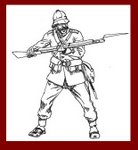Zanzibari Slavers vs. Masai Villagers
By Edward Harvey at the Heliograph Colonial Gaming Magazine
http://www.theheliograph.com/index.html
“Burn it!” shouted the health officer, and within seconds torches were produced from within the throng gathered about the thatched cottages. The old games keeper at the back of the crowd hastily shouldered his firearm and stepped backwards, treading as he did so on the foot of a late-comer behind him. “Boody ‘ell!” shouted the man, caressing his foot and glaring at the games keeper as he retreated past. The old man was oblivious to his scorn, however, his mind awash with disconcerting memories of a day thirty years previous…when his lordship was still without title and was idle with sport…set under a much hotter sun.
Background
This scenario is intended for use with the “In the Heart of Africa” wargame rules 1st edition published by HLBS and is intended to simulate an attack on a Masai village led by Zanzibari slavers. In the recent past Zanzibari slaving expeditions have been preyed upon by the Masai in question and in an effort to eliminate this threat the slavers have organized an attack on their village, recruiting to their cause a neighboring tribe victimized by Masai cattle raids.
It was a common practice among the Masai for the young unmarried men to live some distance apart from the main village, and the Zanzibari hope to capitalize on this arrangement and defeat the younger warriors before the rest of the tribe can arrive to assist them. Unbeknownst to the Zanzibari, however, the Masai have been entertaining a young British heir and his hunting expedition who have little reservation about showing their gratitude to their hosts by training their sporting guns on the slavers!
Forces Involved
1) The Zanzibari (Point Cost)
1 Leader (swordsman) with 3 attendants (14)
1 Standard Bearer (50)
1 Unit of Swordsmen with 8 men (112)
4 Units of Askari with 8 men each (256)
Points Total (432)
This scenario involves the use of two separate tabletops or playing surfaces as described below under the section “The Battlefield.” The Zanzibari units begin play on the eastern, northern, or southern edges of table 2. All the units do not have to begin on the same table edge.
2) The Native Tribesman (Allies to the Zanzibari) (Point Cost)
1 Leader (spearman) with 3 attendants (3)
2 Units of Spearmen with 16 men each (96)
1 Unit of Archers with 8 men (32)
Points Total (131)
The native tribesman setup is identical to that of the Zanzibari.
3) The Main Masai Force (Point Cost)
1 Leader with 3 attendants (9)
4 Units of Warriors with 7 men each (252)
Points Total (261)
These units begin play within the main Masai village.
4) The Hunting Party (Point Cost)
1 Unit consisting of 3 White Men and 2 Gun Bearers (160)
1 Unit of Masai Warriors with 4 men (36)
Points Total (196)
At the beginning of the game the British heir and his hunting party are not present but are assumed to be scouring the country east of the battle for lions. They are accompanied by a small number of young Masai who possess intimate knowledge of the local lion population and are serving the party as guides. As an act of initiation into the warrior class young Masai would traditionally hunt lions armed only with shield and spear. It is their expert knowledge of lions in the village’s vicinity that first led the British hunters to solicite their aid. Beginning on turn 5 the gamemaster (GM) should begin secretly dicing for the arrival of the hunting party.
The probability of their arriving per turn is as follows:
| Turn | Number on a d6 needed |
| 5 | 1 |
| 6 | 1-2 |
| 7 | 1-3 |
| 8 | 1-4 |
| 9 | 1-5 |
| 10 | arrive automatically |
They begin play at one of the trail heads found on table 2’s north, east, and southern edges. Additionally the player controlling the hunting party will also command three small groups of Masai warriors who begin play at the beginning of the game within the unmarried men’s encampment:
The Unmarried (Junior) Masai Warriors (Point Cost)
3 Units of Warriors with 5 men each (135)
This player is also responsible for controlling 3 baggage elements (representing cattle). Each playing surface should be divided up into 4 quadrants (for a total of 8 quadrants) and the location of each element should be diced for randomly at the beginning of the game using a d8.
The Masai players should place their units first (including the baggage elements) followed by the Native Tribesmen and then the Zanzibari. The Masai players should not know at which table their enemies are to appear until they have first placed their units.
Objectives
The Zanzibari objectives are to occupy both the unmarried men’s camp and the main village proper with at least one unit for two entire turns (it only counts as occupying the objectives if no defending figures are inside them at any time during that turn). Additionally, the Zanzibari player must eliminate in its entirety the hunting party (excluding the Masai guides), as their survival and subsequent account of the slaver’s actions would create significant political troubles for Zanzibar’s government. Note that failure to do so results in an automatic defeat for the Zanzibari player, even if he has occupied one or both of the aforementioned ground objectives. The Zanzibari player has 12 turns to accomplish his goals at which time the game is considered ended.
The native tribesman allied to the Zanzibari also achieve a victory if both ground objectives are occupied by either Zanzibari or native units. Unlike the Zanzibari, however, their victory is not erased by the survival of members of the hunting party. Additionally, the native player may also secure a win by capturing at least 2 baggage elements by turn 10. The Zanzibari player should not know in precise terms the victory conditions of their allied native player; the GM should warn him just prior to the battle though that his allies seem as intent on the reacquisition of cattle as they do on the destruction of the Masai. Native efforts to capture cattle (which gives them an “out” should the fight for the camp and village go badly) may, of course, lead to disagreement between the Zanzibari and native players. In this case the GM should not attempt to arbitrate! The native tribesman are present voluntarily, after all, and if their player can withstand the scorn heaped on him by the Zanzibari player then so will the lead casting that represents him on the table.
The Masai players win by avoidance of their enemy’s victory conditions. Note that it is possible for both the Zanzibari and Masai players to lose if the Zanzibari are complete in their occupation and destruction of the Masai camp and village but fail to eliminate the hunting party. It is also possible for the Masai to achieve a victory over the Zanzibari (by preventing occupation of the village) but lose to Zanzibari’s native allies (through the theft of cattle).
The Battlefield
In order to simulate the dis-coordinate efforts of the Masai in the main village and the unmarried men’s camp, two playing surfaces are required for this scenario. One playing surface should measure approximately 5 feet x 3 feet and for the purposes of this scenario will be identified as table 1. The main Masai village surrounded by a thorny enclosure is located on the westernmost edge of this table. The other playing surface should measure 5 feet x 5 feet and is designated table 2. The unmarried men’s camp is situated squarely in its center. Note that it was a Masai practice to deliberately leave these camps without defenses in order to cultivate vigilance and wartime readiness in the junior warriors and it therefore lacks an enclosure.
Table 1 is considered to be contiguous to and lie directly west of table 2. In practice, these tables (or playing surfaces) can be physically adjacent to one another if separated by a curtain or blind; they may alternatively be set up in separate gaming rooms.
In either case, the Masai forces issuing from the village should not be able to view events transpiring on table 2 until at least one of their units is within 16 inches of the eastern edge of their table. Likewise, the junior Masai warriors should not be able to view events transpiring on table 1 until they too have at least one unit within 16 inches of their western table edge. The GM is allowed to offer the player commanding the main Masai force clues as to events occurring on table 2 before he is actually allowed to view said table (for example the GM may tell him he hears heavy gunfire or sees a column of smoke issuing from the junior warrior’s camp if it is occupied). The Zanzibari and allied tribal players may view both tables freely at any time (it is assumed they have scouts who have infiltrated the approaches to the main village and are observing the movements of the Masai assembling there).
The Hunting Parties Camp
Though not marked on the map, there is considered to be several tents pitched next to the unmarried men’s camp. These belong to the hunting party and should be placed on the table when the Zanzibari/native allied troops move within 16 inches of the camp. These tents will offer to the Zanzibari the first indication that their mission is more complicated than they had first anticipated. If the Zanzibari occupy the camp for at least one turn then the GM should read to them the following description:
“A quick inventory of the camp reveals a veritable armory--full of rifles and munitions though several gun cases are conspicuously empty. Several large game trophies in various stages of taxidermic preparation are also present. The tents appear unoccupied with one exception…”
Asleep and entirely oblivious to the fighting without is one of the British heir’s servants who has been laid low by fever (he is the unfortunate games keeper described in the prelude to this scenario incidentally). He is full of pluck but in his weakened state may reveal information regarding the hunting party if subjected to torture. Torture can only be performed by a Zanzibari figure and one roll with a d8 on the torture table is allowed per turn. Add a +1 to the roll if the torturer is the Zanzibari leader.
| Number | Result |
| 1 | In the confusion the prisoner escapes, killing his captor in the process. |
| 2 | In the confusion the prisoner escapes. |
| 3 | The prisoner lies convincingly about the hunting party’s makeup and location. The GM should matter-of-factly tell the Zanzibari player that there are 6 hunters and point out to him an incorrect trail along which they are to appear. The GM should obviously ascertain from the Masai player which trail he actually intends the party to appear at beforehand. |
| 4 | The prisoner divulges no information. |
| 5 | The prisoner divulges no information but appears to be weakening. Add +1 to the next dice roll attempt. |
| 6 | The prisoner lapses into unconsciousness. He may be reinterrogated next turn. Add +2 to the next dice roll attempt. |
| 7-8 | The prisoner reveals the correct number of hunters in the party and along which trail they are to appear. No mention is made of the Masai accompanying them. |
Once the Zanzibari player becomes aware of the hunting parties existence (either through successful interrogation of the servant or by the actual appearance of said party), then the GM should inform him of his additional victory condition, i.e. the elimination of the hunters and their gun bearers.
If the Zanzibari and their native allies succeed in eliminating all the Masai units from table 2 and there are no Masai units within 16 inches of the eastern edge of table 1, then they may detach one of their units to occupy the unmarried men’s camp in preparation for ambushing the hunting party (refer to the ambush section in the rules). This can only be done if the hunting party has not yet arrived on the table. Note that units hidden behind table 2’s escarpment can also ambush the party if it’s approaching from the lower ground to the east. The Zanzibari/native ally players should obviously confer with the GM regarding the disposition of these hidden units.
Hope you enjoy the scenario. Before running a game the GM will probably need to read through it a couple of times with careful attention given to what the players know and when. As a reminder, though, the Zanzibari player has no knowledge of the hunting party at the game’s outset and only a suspicion regarding his native ally’s optional victory conditions.































2 comments:
Great scenario!
This might be worth a go!
Post a Comment